Ultrahigh Sensitivity Graphene Infrared Detectors for Imaging and Spectroscopy
31 January 2017
The Cambridge Graphene Centre, in collaboration with researchers from Nokia UK, Emberion, and other partners from the Graphene Flagship have developed a novel graphene-based infrared (IR) detector with record high sensitivity for thermal detection. This result paves the way for high-performance IR imaging and spectroscopy.
Versarien acquires majority stake in Cambridge Graphene Centre spin-out Cambridge Graphene
20 January 2017
A majority stake in Cambridge Graphene Ltd., a spin-out company from the University of Cambridge, has been acquired by Versarien plc. Cambridge Graphene develops inks based on graphene and related materials using processes developed at the Cambridge Graphene Centre. The spin-out company has commercialised graphene inks for novel technology applications.
Graphene’s sleeping superconductivity awakens
19 January 2017
Scientists have believed that graphene may have the innate ability to superconduct since graphene was isolated in 2004. Now Cambridge researchers have found a way to activate that previously dormant potential.
Graphene inks take first prize in Engineering Department Photography Competition
29 November 2016
James Macleod, Process Technician at the Cambridge Graphene Centre, has won first prize in the Department of Engineering's annual Photography Competition. The winning image features graphene ink being processed in alcohol in the CGC microfluidiser, where graphite is ripped apart into graphene by shear forces. Shimmering black swirls show graphene in different stages of exfoliation as it is processed up to 70 times. His prize is a pair of Victory 8x42SF binoculars, from the competition sponsors, ZEISS.
Click here to find out more and see the winning image!
Environmentally-friendly graphene textiles could enable wearable electronics
25 November 2016
Researchers from the Cambridge Graphene Centre, working in collaboration with researchers from Jiangnan University, China, have devised a new method for producing conductive cotton fabrics using graphene-based inks. The new method, detailed in the journal Carbon, opens up new possibilities for flexible and wearable electronics, without the use of expensive and toxic processing steps. Conductive fabrics are expected to become important for healthcare sensors, high-performance clothing, and energy conversion.
Click here to find out more.
Shedding more light on graphene nanoribbons
4 March 2016
Researchers in Germany, Italy and the UK have made the first systematic analysis of the Raman spectrum of four different types of ultra-narrow graphene nanoribbons (GNRs), showing that the width, edge geometry and functional groups on the ribbons all affect the Raman features – especially those at low energy. The new work provides fresh insights into how the vibrational and electronic properties of nanostructures change with their dimensionality and proves that Raman spectroscopy is a powerful characterizion tool for GNRs.
Click here to find out more.
Graphene takes centre stage at Mobile World Congress
23 February 2016
The Cambridge Graphene Centre, together with several of its industrial and academic partners – such as Cambridge-based Nokia, Aixtron, Novalia and Flexenable – have unveiled the inaugural Graphene Pavilion at the 2016 Mobile World Congress (MWC), the world’s largest gathering for the mobile industry with more than 100,000 attendees and 2000 exhibitors. The Graphene Pavilion is a unique space to explore the latest graphene based innovations with numerous prototypes and demonstrations.
Youtube Click here to find out more.
Graphene shown to safely interact with neurons in the brain
29 January 2016
Researchers have shown that graphene can be used to make electrodes that can be implanted in the brain, which could potentially be used to restore sensory functions for amputee or paralysed patients, or for individuals with motor disorders such as Parkinson’s disease.
"We are just at the tip of the iceberg when it comes to the potential of graphene and related materials in bio-applications and medicine." Andrea Ferrari
Researchers have successfully demonstrated how it is possible to interface graphene – a two-dimensional form of carbon – with neurons, or nerve cells, while maintaining the integrity of these vital cells. The work may be used to build graphene-based electrodes that can safely be implanted in the brain, offering promise for the restoration of sensory functions for amputee or paralysed patients, or for individuals with motor disorders such as epilepsy or Parkinson’s disease. The research, published in the journal ACS Nano, was an interdisciplinary collaboration coordinated by the University of Trieste in Italy and the Cambridge Graphene Centre. Previously, other groups had shown that it is possible to use treated graphene to interact with neurons. However the signal to noise ratio from this interface was very low. By developing methods of working with untreated graphene, the researchers retained the material’s electrical conductivity, making it a significantly better electrode.
“For the first time we interfaced graphene to neurons directly,” said Professor Laura Ballerini of the University of Trieste in Italy. “We then tested the ability of neurons to generate electrical signals known to represent brain activities, and found that the neurons retained their neuronal signalling properties unaltered. This is the first functional study of neuronal synaptic activity using uncoated graphene based materials.”
Our understanding of the brain has increased to such a degree that by interfacing directly between the brain and the outside world we can now harness and control some of its functions. For instance, by measuring the brain's electrical impulses, sensory functions can be recovered. This can be used to control robotic arms for amputee patients or any number of basic processes for paralysed patients – from speech to movement of objects in the world around them. Alternatively, by interfering with these electrical impulses, motor disorders (such as epilepsy or Parkinson’s) can start to be controlled. Scientists have made this possible by developing electrodes that can be placed deep within the brain. These electrodes connect directly to neurons and transmit their electrical signals away from the body, allowing their meaning to be decoded. However, the interface between neurons and electrodes has often been problematic: not only do the electrodes need to be highly sensitive to electrical impulses, but they need to be stable in the body without altering the tissue they measure. Too often the modern electrodes used for this interface (based on tungsten or silicon) suffer from partial or complete loss of signal over time. This is often caused by the formation of scar tissue from the electrode insertion, which prevents the electrode from moving with the natural movements of the brain due to its rigid nature. Graphene has been shown to be a promising material to solve these problems, because of its excellent conductivity, flexibility, biocompatibility and stability within the body. Based on experiments conducted in rat brain cell cultures, the researchers found that untreated graphene electrodes interfaced well with neurons. By studying the neurons with electron microscopy and immunofluorescence the researchers found that they remained healthy, transmitting normal electric impulses and, importantly, none of the adverse reactions which lead to the damaging scar tissue were seen. According to the researchers, this is the first step towards using pristine graphene-based materials as an electrode for a neuro-interface. In future, the researchers will investigate how different forms of graphene, from multiple layers to monolayers, are able to affect neurons, and whether tuning the material properties of graphene might alter the synapses and neuronal excitability in new and unique ways.
“Hopefully this will pave the way for better deep brain implants to both harness and control the brain, with higher sensitivity and fewer unwanted side effects,” said Ballerini.
“We are currently involved in frontline research in graphene technology towards biomedical applications,” said Professor Maurizio Prato from the University of Trieste. “In this scenario, the development and translation in neurology of graphene-based high-performance biodevices requires the exploration of the interactions between graphene nano- and micro-sheets with the sophisticated signalling machinery of nerve cells. Our work is only a first step in that direction.”
“These initial results show how we are just at the tip of the iceberg when it comes to the potential of graphene and related materials in bio-applications and medicine,” said Professor Andrea Ferrari, Director of the Cambridge Graphene Centre. “The expertise developed at the Cambridge Graphene Centre allows us to produce large quantities of pristine material in solution, and this study proves the compatibility of our process with neuro-interfaces.”
The research was funded by the Graphene Flagship, a European initiative which promotes a collaborative approach to research with an aim of helping to translate graphene out of the academic laboratory, through local industry and into society.
Reference: Fabbro A., et. al. ‘Graphene-Based Interfaces do not Alter Target Nerve Cells.’ ACS Nano (2016).DOI: 10.1021/acsnano.5b05647 (2015)
IET A F Harvey Engineering Research Prize
26 Nov 2015
Professor Yang Hao, a member of management team of Cambridge Graphene Center, was yesterday announced as the winner of the £300,000 IET A F Harvey Engineering Research Prize.
He was chosen from high-calibre candidates from across the world as a result of his outstanding contributions in the fields of microwave, antennas and electromagnetics.
More about the prize and achievement are available at the following link
Cambridge Graphene Technology Days
5 Nov 2015
The largest-ever showcase of companies developing new technologies from graphene and other two-dimensional materials is taking place in Cambridge this week.
Around 50 UK and global companies are showcasing their graphene-related technology and products at the launch of the university’s Cambridge Graphene Centre on Thursday and Friday (November 5 & 6).
The Graphene Technology Days at the centre’s West Cambridge site will feature exhibitions by a range of companies, tours of the research facilities at the centre and presentations from CGC director Andrea Ferrari, university vice-chancellor Professor Sir Leszek Borysiewicz and others.
The full program is available here.
Extreme engineering for Cambridge youngsters and their adults
By Francis Sedgemore, 10 April 2015
Research students from the University of Cambridge engineering department's EPSRC Centre for Doctoral Training in Graphene Technology recently attended an outreach event hosted by the Cambridge Science Centre. Over the course of the day, several hundred mostly young children and their parents looked at and learned about extreme engineering, graphene included.
CDT students demonstrated the famous sticky-tape method for producing graphene from pencil traces on paper, and encouraged the visitors to try it themselves. The results of this simple but effective graphene 'exfoliation' technique were then studied through a microscope. Parents meanwhile looked on, with some of them asking searching questions of the graphene scientists.
"It was great to see both the parents and their kids interested in graphene technology, and engaging with our activities," said CDT research student Vinay Malhotra. "We were struck by their optimistic enthusiasm for graphene and its future applications!"
Other hands-on demonstrations included a graphene-based drum produced by Cambridge printed electronics pioneer Novalia, the construction of model molecules with marshmallows and sticks, and an investigation into the motive effects of surface tension in a bowl of water.
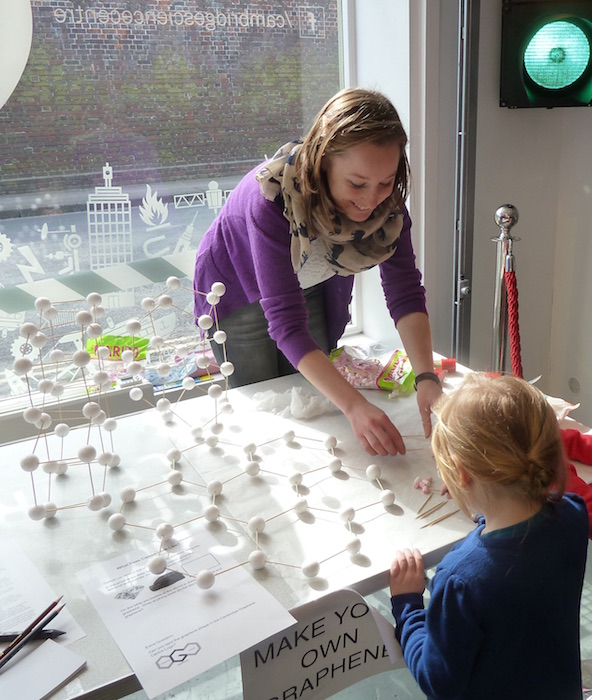
Image: Cambridge University research student Philippa Hooper with a young graphene scientist in the making (photo by Catherine Taylor, copyright © 2015 University of Cambridge).
For further details please contact the Science Writer for the Graphene Flagship and Cambridge Graphene Centre.
The European roadmap for graphene science and technology
Europe's Graphene Flagship lays out a science and technology roadmap, targeting research areas designed to take graphene and related two-dimensional materials from academic laboratories into society.
This publication concludes a four-year effort to collect and coordinate state-of-the-art science and technology of graphene and related materials
Andrea Ferrari
In October 2013, academia and industry came together to form the Graphene Flagship. Now with 142 partners in 23 countries, and a growing number of associate members, the Graphene Flagship was established following a call from the European Commission to address big science and technology challenges of the day through long-term, multidisciplinary R&D efforts.
In an open-access paper published in the Royal Society of Chemistry journal Nanoscale, more than 60 academics and industrialists lay out a science and technology roadmap for graphene, related two-dimensional crystals, other 2D materials, and hybrid systems based on a combination of different 2D crystals and other nanomaterials. The roadmap covers the next ten years and beyond, and its objective is to guide the research community and industry toward the development of products based on graphene and related materials.
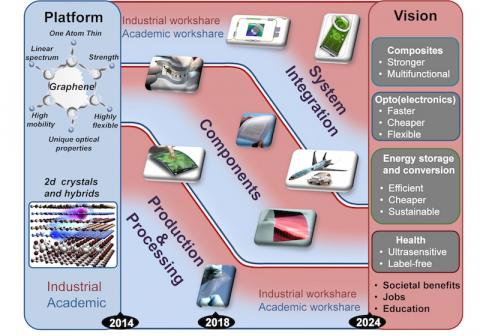
Graphene - a two-dimensional material made up of sheets of carbon atoms - and related materials are expected to revolutionise the fields in which they are applied, and they have the potential to become the materials of the 21st century. They will supplement and at times replace existing substances in a range of applications. Two-dimensional materials shall in some cases be integrated into existing platforms in order to enhance them. For example, graphene could be integrated into silicon photonics, exploiting established technology for constructing integrated circuits.
The roadmap highlights three broad areas of activity. The first task is to identify new layered materials, assess their potential, and develop reliable, reproducible and safe means of producing them on an industrial scale. Identification of new device concepts enabled by 2D materials is also called for, along with the development of component technologies. The ultimate goal is to integrate components and structures based on 2D materials into systems capable of providing new functionalities and application areas.
Eleven science and technology themes are identified in the roadmap. These are: fundamental science, health and environment, production, electronic devices, spintronics, photonics and optoelectronics, sensors, flexible electronics, energy conversion and storage, composite materials, and biomedical devices. The roadmap addresses each of these areas in turn, with timelines.
Research areas outlined in the roadmap correspond broadly with current flagship work packages, with the addition of a work package devoted to the growing area of biomedical applications, to be included in the next phase of the flagship. A recent independent assessment has confirmed that the Graphene Flagship is firmly on course, with hundreds of research papers, numerous patents and marketable products to its name.
Roadmap timelines predict that, before the end of the ten-year period of the flagship, products will be close to market in the areas of flexible electronics, composites, and energy, as well as advanced prototypes of silicon-integrated photonic devices, sensors, high-speed electronics, and biomedical devices.
"This publication concludes a four-year effort to collect and coordinate state-of-the-art science and technology of graphene and related materials," says Andrea Ferrari, director of the Cambridge Graphene Centre, and chairman of the Executive Board of the Graphene Flagship. "We hope that this open-access roadmap will serve as the starting point for academia and industry in their efforts to take layered materials and composites from laboratory to market." Ferrari led the roadmap effort with Italian Institute of Technology physicist Francesco Bonaccorso, who is a Royal Society Newton Fellow of the University of Cambridge, and a Fellow of Hughes Hall.
"We are very proud of the joint effort of the many authors who have produced this roadmap," says Jari Kinaret, director of the Graphene Flagship. "The roadmap forms a solid foundation for the graphene community in Europe to plan its activities for the coming years. It is not a static document, but will evolve to reflect progress in the field, and new applications identified and pursued by industry."
Looking at graphene and other 2d crystals in energy conversion and storage
by Francis Sedgemore, 16 February 2015
 Scientists working with Europe's Graphene Flagship and the Cambridge Graphene Centre have provided a detailed and wide-ranging review of the potential of graphene and related materials in energy conversion and storage.
Scientists working with Europe's Graphene Flagship and the Cambridge Graphene Centre have provided a detailed and wide-ranging review of the potential of graphene and related materials in energy conversion and storage.
In a review article published recently in Science, the researchers, led by Francesco Bonaccorso, a Royal Society Newton Fellow at the Cambridge Graphene Centre, note the substantial progress made in material preparation at the laboratory level. They also highlight the challenge of producing the materials on an industrial scale in a cost-effective manner. Graphene and related two-dimensional crystals may play a major role in future energy conversion and storage technologies, and this is an active area of research and development for Graphene Flagship partners such as the Cambridge Graphene Centre.
"The huge interest in 2d crystals for energy applications comes both from their physico-chemical properties, and the possibility of producing and processing them in large quantities, in a cost-effective manner," says Bonaccorso. "In this context, the development of functional inks based on 2d crystals is the gateway for the realisation of new generation electrodes in energy storage and conversion devices." Bonaccorso adds that the challenge ahead is to demonstrate a disruptive technology in which 2d materials not only replace traditional electrodes, but more importantly enable whole new device concepts.
Review co-author Andrea Ferrari, who chairs the Executive Board of the Graphene Flagship, and is director of the Cambridge Graphene Centre, offers a soberly optimistic view: "Graphene and related materials have great promise in these areas, and the Graphene Flagship has identified energy applications as a key area of investment. We hope that our critical overview will guide researchers in academia and industry in identifying optimal pathways toward applications and implementation, with an eventual benefit for society as a whole."
Published on the website of the Graphene Flagship is a detailed popular presentation of the Science review.
For further details please contact the Science Writer
Image: "Francesco Bonaccorso, a Royal Society Newton Fellow at the Cambridge Graphene Centre (photo copyright © 2015 Agnese Abrusci/Instituto Italiano di Tecnologia)."
Nippon Kayaku becomes an industrial partner of the Cambridge Graphene Centre
by Francis Sedgemore, 21 January 2015
Nippon Kayaku Co. Ltd, a Japanese chemicals manufacturer with global activities in functional materials, pharmaceuticals, automotive safety components and agrochemicals, is to partner with the Cambridge Graphene Centre.
Nippon Kayaku will support the Centre for Doctoral Training in Graphene Technology, focussing on the innovative use of graphene in applications that benefit Nippon Kayaku's business portfolio. The company specialises in advanced resin materials and polymers, and is researching the benefits to be achieved from the incorporation of graphene into its composite materials mix.
The Cambridge Graphene Centre, carries out research into the science and technology of graphene and related two-dimensional materials. Industrial innovation is central to its mission, as are academic-industrial partnerships such as this new venture with Nippon Kayaku.

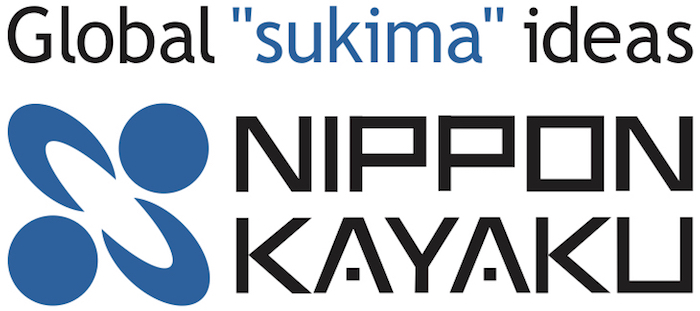
Contacts
For further details please contact the Science Writer
Yasuhiro Magatani, General Manager, R&D Planning Division, Nippon Kayaku Co. Ltd. - email: yasuhiro.magatani@nipponkayaku.co.jp; telephone: +81 3 3598 3974.
Cambridge CDT in Graphene Technology welcomes its first students
by Francis Sedgemore, 8 January 2015
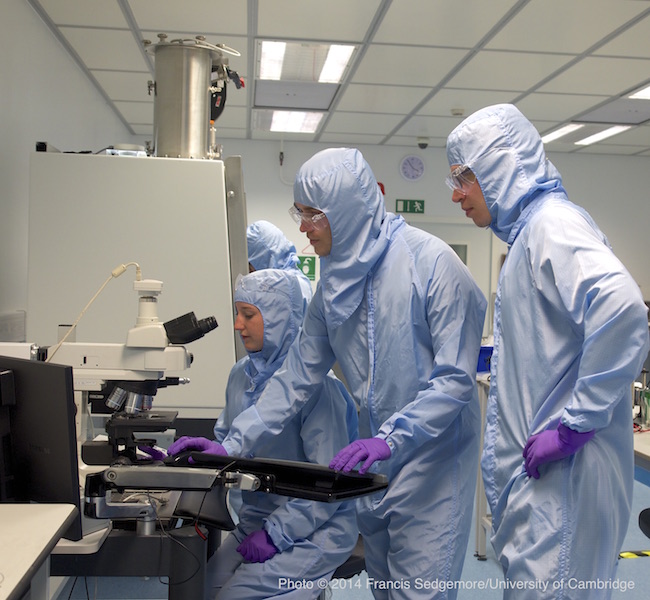 Based at the University of Cambridge, the EPSRC Centre for Doctoral Training in Graphene Technology is one of a number of research training initiatives devoted to the science and engineering of graphene and related two-dimensional materials. The aim of the CDTs is to deliver a high-quality, student-centred approach to training, and create a world-class cohort of early career scientists who will in turn become the next generation of entrepreneurs and technology leaders.
Based at the University of Cambridge, the EPSRC Centre for Doctoral Training in Graphene Technology is one of a number of research training initiatives devoted to the science and engineering of graphene and related two-dimensional materials. The aim of the CDTs is to deliver a high-quality, student-centred approach to training, and create a world-class cohort of early career scientists who will in turn become the next generation of entrepreneurs and technology leaders.
The focus of the CDT in Graphene Technology is cutting-edge engineering and industrial applications for graphene and related materials, and the centre exploits the close links between academia and industry in the Cambridge Cluster. Most of the project partners are commercial companies, with the remainder being research institutes and technology transfer, innovation and business development agencies.
Industry contributes practically to the CDT through research projects, lectures, seminars and workshops.
Funded with over £4.6m from EPSRC, the CDT in Graphene Technology began life in October 2014. Six of the eight students fully within the CDT are funded by the research council, one is sponsored by industry, and another by the European Research Council. A ninth PhD student benefits from a close association with the CDT.
CDT students follow a four-year programme, with an MRes degree in year one, and a PhD research project in years two to four. During the first year, students undertake short research projects, and attend courses covering such things as business skills development, public outreach and engagement. In terms of time allocation, a little over half is spent on research, and the remainder devoted to taught courses. The PhD element of the programme is industry-focused, and the students get to choose their research topics at the end of the first year.
CDT programmes provide PhD students with a set of transferable and marketable skills, ranging from the detail of graphene and related materials to the more general aspects of flexible and wearable electronics, photonics, energy storage, RF systems, project management and more.
"The Graphene Technology CDT provides us a unique provision for training the next generation of technology leaders and entrepreneurs," says Tawfique Hasan, deputy director for teaching and training with the CDT. "With the CDT we hope to engineer a future with more efficient, functional and affordable technologies."
The CDT in Graphene Technology will run initially until September 2022.
Announcing the HVM Graphene+ expo for 2015
by Francis Sedgemore, 14 November 2014.

In a little under three months from now, Cambridge will host the third High Value Manufacturing Graphene+ expo. The event takes place over two days, from 9-10 February 2015.
During HVM Graphene+ 2015, buyers and sellers of graphene and related two-dimensional materials, corporates and brand owners will meet to discuss technological detail and the graphene market, with the expo providing an excellent opportunity for participants to do business together. The focus of the expo will be on sensors, devices and electronics for automotive, aerospace, manufacturing, communications, Internet of Things and Machine to Machine applications.
HVM Graphene+ 2015 is organised by Cambridge Investment Research Ltd, a technology-centred management consultancy based at the university city's ideaSpace complex.
For further information, including details of how to reserve places, check out the Graphene+ 2015 website.
For media enquiries relating to the research and development activities of Europe's Graphene Flagship and the Cambridge Graphene Centre, for further details please contact the Science Writer
Cambridge student flies the flag for European graphene research
A young researcher from the Cambridge Graphene Centre recently represented Europe's Graphene Flagship at the Digital Action Day 2014 in Brussels. At the event held on Monday 29 September, timed to mark the end of Neelie Kroes' term as Information Commissioner and Commission Vice-President, PhD student Flavia Tomarchio gave a practical demonstration of graphene technology, together with a popular exposition of the science of layered nanomaterials.
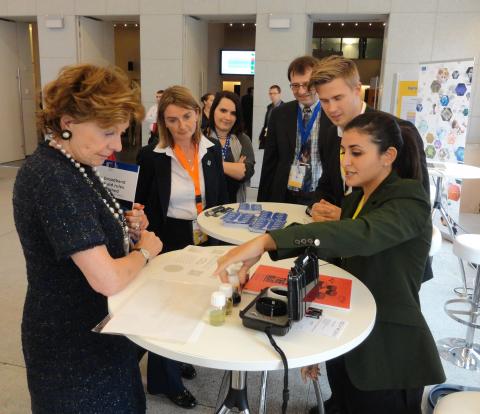
Flavia, whose expertise is in the use of graphene in the pixel electronics of flexible displays, put together a presentation in the foyer of a conference centre in central Brussels. By all accounts, Flavia made a big impression on visitors to the stand of the Graphene Flagship. Pictured here is Flavia talking to Commissioner Kroes about graphene inks, with curious EC officials and others looking on.
Digital Action Day 2014 featured plenary sessions and parallel group discussions aimed primarily at policymakers and technology journalists, focused on the transformative and disruptive power of digital technologies. Both of the European Commission's Future and Emerging Technologies flagships - the Graphene Flagship and Human Brain Project - were present to display their wares and report on progress during the first year of operation.
Image: PhD student Flavia Tomarchio of the Cambridge Graphene Centre, explaining the wonders of graphene to European Commission Vice-President Neelie Kroes (copyright © 2014 Guy Willis/Human Brain Project).
For further details please contact the Science Writer
Duxford's shining stars
Cambridge Graphene Centre students shine in graduate conference presentations
Three research students based at the Cambridge Graphene Centre have won awards for their presentations to the university's electrical engineering graduate conference for 2014, held on 10 September 2014 at Duxford. The conference saw first and second year students judged by their senior peers, and otherwise focused on career development, and the acquisition and refinement of professional communication skills.
Flavia Tomarchio won second prize for her talk at the conference, on the use of graphene in the pixel electronics of flexible displays. Domenico De Fazio achieved similar recognition for his poster on graphene and layered materials in optoelectronics applications, whilst a third doctoral student, Ugo Sassi, was judged to have presented the most inspiring image, named "Graphene stars".
The young researchers' contribu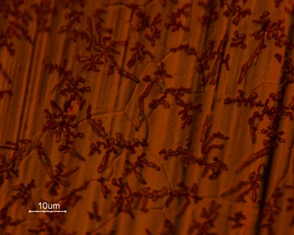 tions to the conference were accompanied by those of guest speakers. These included the then head of engineering, Professor Dame Ann Dowling, and Professor Sir Mark Welland, director of the Nanoscience Centre.
tions to the conference were accompanied by those of guest speakers. These included the then head of engineering, Professor Dame Ann Dowling, and Professor Sir Mark Welland, director of the Nanoscience Centre.
One of the visiting speakers, Richard Mullender, a former hostage negotiator with the Metropolitan Police, discussed professional communication as a process of listening to and absorbing complex information, as well as talking and writing. Keen listener Flavia Tomarchio spoke glowingly about Mr Mullender, whose message was clearly taken on board by the aspiring scientists and engineers in his audience at Duxford.
10 Sept 2014.
Image: "Graphene Stars" copyright © 2014 Ugo Sassi.
For further details please contact the Science Writer
A majority stake in Cambridge Graphene Ltd., a spin-out company from the University of Cambridge, has been acquired by Versarien plc.
Cambridge Graphene develops inks based on graphene and related materials using processes developed at the Cambridge Graphene Centre. The spin-out company has commercialised graphene inks for novel technology applications.

